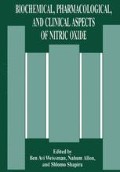Abstract
Oxygen free radical generation has been implicated in mediating signal transmission initiated by a variety of stimuli (1–4). For example, Novogrodsky et al. (2) discovered that hydroxy radical scavengers blocked phorbol ester-induced mitogenesis in lymphocytes. Also, Schreck et al. (1) found that treating T lymphocytes with the free radical scavenger N-acetylcysteine, blocked activation of the nuclear transcription factor NF-κB by a variety of unrelated stimuli. We discovered various inductive effects which oxidants and other stress stimuli, such as Hg2+ and phenylarsine oxide, have on resting human peripheral blood mononuclear cells (PBMC) (5–9). We examined early parameters of cellular activation, including the rate of glucose uptake, p56lck protein tyrosine kinase activity and CD45 protein tyrosine phosphatase activity. The ability of hemin, Hg2+ and phenylarsine oxide to activate this signal transduction pathway led us to examine whether a more biologically relevant oxidant, nitric oxide, had similar effects (10).
Access this chapter
Tax calculation will be finalised at checkout
Purchases are for personal use only
Preview
Unable to display preview. Download preview PDF.
References
Schreck, R., P. Rieber, and P. A. Baeuerle, 1991, Reactive oxygen intermediates as apparently widely used messengers in the activation of the NF-KB transcription factor and HIV-1. Embo J. 10, 2247.
Novogrodsky, A., A. Ravid, A. L. Rubin, and K. H. Stenzel, 1982, Hydroxyl radical scavengers inhibit lymphocyte mitogenesis. Proc. Natl. Acad. Sci. USA. 79, 1171.
Whitacre, C. M., and M. K. Cathcart, 1992, Oxygen free radical generation and regulation of proliferative activity of human mononuclear cells responding to different mitogens. Cell. Immunol. 144, 287.
Israel, N., M-A. Gougerot-Pocidalo, F. Aillet, and J-L. Verelizier, 1992, Redox status of cells influences constitutive or induced NF-KB translocation and HIV LTR activity in human and monocytic cell lines. J. Immunol. 149, 3386.
Lander, H. M., D. M. Levine, and A. Novogrodsky, 1992, Stress Stimuli-Induced Lymphocyte Activation. Cell. Immunol. 145, 146.
Lander, H. M., D. M. Levine, and A. Novogrodsky, 1993, Hemin Enhancement of Glucose Transport in Human Lymphocytes: Stimulationof Protein Tyrosine Phosphatase and Activation of p56lck Tyrosine Kinase. Biochem. J. 291, 281.
Stenzel, K. H., A. L. Rubin, and A. Novogrodsky, 1981, The mitogenic and co-mitogenic properties of hemin. J. Immunol. 127, 2469.
Novogrodsky, A., M. Suthanthiran, and K. H. Stenzel, 1989, Immune stimulatory properties of metalloporphyrins. J. Immunol. 143, 3981.
Novogrodsky, A., M. Suthanthiran, and K. H. Stenzel, 1991, Ferro-mitogens: iron-containing compounds with Iymphocyte-stimulatoryproperties. Cell. Immunol. 133, 295.
Lander, H. M., P. Sehajpal, D. M. Levine, and A. Novogrodsky, 1993, Activation of Human Peripheral Blood Mononuclear Cells by Nitric Oxide Generating Compounds. J. Immunol. 150, 1509.
Budavari, S, ed., 1989, in: The Merck Index, Merck & Co., Inc., Rahway, NJ, 1989, p. 275.
Downward, J., J. D. Graves, P. H. Warne, S. Rayter, and D. Cantrell, 1990, Stimulationof p21ras upon T cell Activation. Nature. 346, 719.
Lander, H. M., P. K. Sehajpal, and A. Novogrodsky, 1993, Nitric Oxide Signaling: A Possible Role for G Proteins. J. Immunol. 151, 7182.
Devary, Y., C. Rosette, J. A. DiDonato, M. Karin, 1993, NF-KB Activation by Ultraviolet Light Not Dependent on a Nuclear Signal. Science. 261, 1442.
Author information
Authors and Affiliations
Editor information
Editors and Affiliations
Rights and permissions
Copyright information
© 1995 Springer Science+Business Media New York
About this chapter
Cite this chapter
Lander, H.M., Levi, R., Novogrodsky, A. (1995). Nitric Oxide-Induced Lymphocyte Activation: A Role for G Proteins. In: Weissman, B.A., Allon, N., Shapira, S. (eds) Biochemical, Pharmacological, and Clinical Aspects of Nitric Oxide. Springer, Boston, MA. https://doi.org/10.1007/978-1-4615-1903-4_9
Download citation
DOI: https://doi.org/10.1007/978-1-4615-1903-4_9
Publisher Name: Springer, Boston, MA
Print ISBN: 978-1-4613-5777-3
Online ISBN: 978-1-4615-1903-4
eBook Packages: Springer Book Archive

